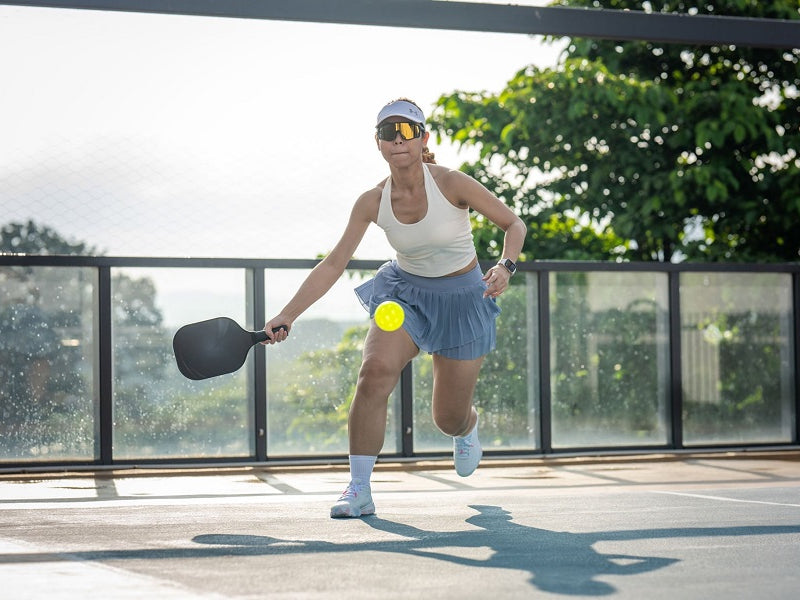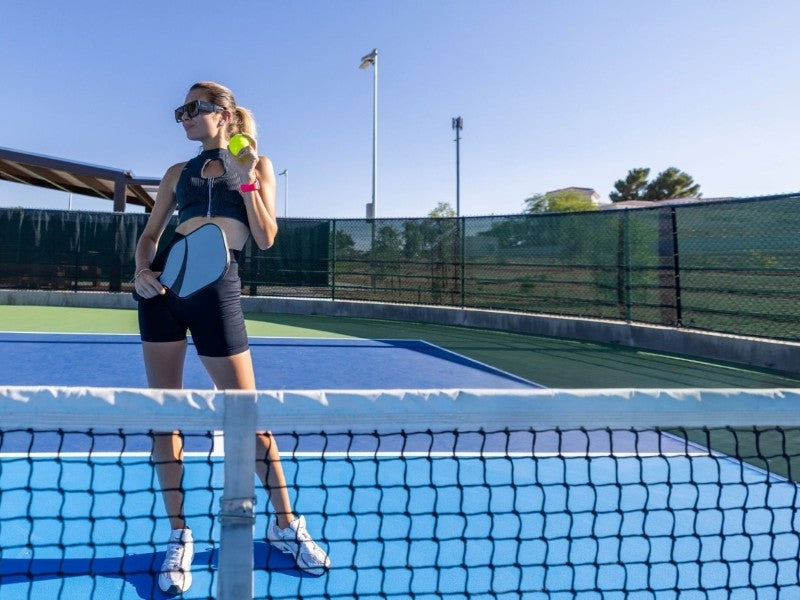If you’ve ever wondered why some players make their serves explode off the paddle while yours feels flat or predictable, the answer lies in technique, timing, and biomechanics — not just raw strength. You’ll learn how to add power, spin, and precision step by step, from your stance and grip to the follow-through and
1. The Common Types of Serves
There are several types of pickleball serves, each with distinct tactical uses:
|
Serve Type |
Description |
When to Use |
|
Flat Serve |
A straightforward, no-spin hit with maximum speed. |
To surprise or overpower opponents. |
|
Topspin Serve |
The paddle brushes upward on the ball, causing it to dip faster. |
Ideal for consistency and deep placement. |
|
Slice or Sidespin Serve |
Brushing motion across the side of the ball. |
To curve the ball away from the opponent or jam their body. |
|
Lob Serve |
A high, deep serve landing near the baseline. |
Slows down the pace, disrupts rhythm. |
|
Soft/Short Serve |
Lands just beyond the kitchen line. |
To catch an aggressive receiver off guard. |
By mastering all of these, you’ll gain tactical variety — making your serves unpredictable and harder to return effectively.
2. Building Raw Power: The Mechanics of a Stronger Serve
Once you understand how energy flows through the kinetic chain, it’s time to translate that into real-world performance.
2.1 The Power Stance
A good stance is your power foundation.
· Feet placement: Shoulder-width apart, lead foot angled about 30° toward your target.
· Weight distribution: 60% on the back foot during setup, then shift forward during the swing.
· Knees bent: A light squat gives you both stability and spring.
· Non-dominant hand: Helps balance and aim before release.
Drill: Practice five “shadow serves” without hitting the ball, focusing on your weight shift — back to front, like a mini-lunge.
2.2 The Loading Phase
Think of this as “charging” your kinetic chain.
1. Backswing: The paddle drops naturally behind you as you rotate your torso.
2. Hip rotation: Twist your hips slightly away from the target — this stores energy like a spring.
3. Shoulder coil: Your upper body turns back as your lower body stays loaded forward.
When you uncoil, this stored energy releases upward and forward, multiplying paddle speed.

2.3 The Contact Phase
This is where precision meets power.
· Contact the ball at waist height or slightly below, in line with USAPA serve rules.
· Strike the ball in front of your lead hip, not directly above your head.
· Paddle face should be slightly open for a deep, driving trajectory.
· Follow through across your body, finishing high for topspin or forward for a flatter serve.
Pro Tip: Power is lost when you decelerate before contact. Focus on accelerating through the ball, not to the ball.
2.4 Follow-Through: The Forgotten Power Booster
Your follow-through determines how effectively energy exits your body and transfers into the ball’s flight. A complete, relaxed follow-through keeps your motion smooth, consistent, and ready for the next shot.
· Let the paddle finish high and forward.
· Keep your chest facing the target after the swing.
· Don’t “brake” your arm — it should flow naturally until the motion ends.
Imagine throwing a ball — your arm doesn’t stop immediately after release; it continues. Serving is the same principle.
2.5 Common Power-Killing Mistakes
|
Mistake |
Why It Hurts |
Fix |
|
Only using arm strength |
Limits kinetic chain |
Engage legs + hips first |
|
Tight grip |
Reduces paddle whip |
Relax your hand pressure |
|
Static stance |
No energy transfer |
Load and shift weight forward |
|
Hitting ball too far back |
Loss of leverage |
Contact ball slightly in front |
|
No follow-through |
Inconsistent power |
Complete your swing naturally |
2.6 Off-Court Power Training
A stronger serve starts off the court. Focus on exercises that develop core rotation, leg drive, and shoulder stability.
Recommended drills:
· Medicine Ball Rotational Throws (3×10): Builds hip and core torque.
· Jump Squats (3×12): Improves leg explosiveness.
· Plank to Side Rotation (3×15 sec each side): Reinforces core control.
· Resistance Band Shoulder Turns (3×12): Strengthens your rotator cuff and improves swing mechanics.
Consistency is key — two to three 30-minute sessions per week can noticeably improve paddle speed and control within a month.
3. How to Add Spin to Your Pickleball Serve
Power alone can win you points, but spin adds deception, control, and unpredictability. Top players use spin not just to make the ball move differently — but to make the receiver guess wrong about where it will land.
3.1 The Physics of Spin
When your paddle brushes the ball at an angle rather than striking it squarely, it creates rotation. This spinning motion interacts with air resistance, altering the ball’s trajectory and bounce:
· Topspin makes the ball dive faster after crossing the net.
· Backspin (slice) makes it float longer and stay low after the bounce.
· Sidespin curves the ball sideways, changing its direction mid-flight.
The trick is controlling how much spin you apply — too much, and the serve slows down; too little, and it loses effect.
3.2 Mastering the Topspin Serve
Topspin is the most versatile and high-percentage serve in pickleball. It gives you safety (since it drops into the court) and depth (since it pushes the opponent back).
Technique Breakdown:
1. Contact point: Slightly below the ball’s equator.
2. Paddle path: From low to high — think of “brushing up” the back of the ball.
3. Wrist action: Snap upward gently through impact to increase spin rate.
4. Follow-through: Continue your swing upward and forward toward your target.
Drill:
· Hit 20 serves aiming to clear the net by 12–18 inches, landing deep in the service box.
· Notice how the ball dips down sharply — that’s your topspin working.
Bonus Tip: Use an Eastern grip (slightly closed paddle face) for easier topspin generation.

3.3 Developing the Slice and Sidespin Serve
A slice serve doesn’t rely on brute force — it uses finesse. Instead of brushing up, you brush across the ball.
Steps:
1. Contact the ball slightly to the side, brushing from 3 o’clock to 9 o’clock (for right-handers).
2. Keep your paddle face slightly open to guide the ball’s path.
3. Shift your body weight forward and across your front leg.
The result? The ball curves through the air and stays low after the bounce, making it tough for opponents to read or attack.
When to Use It:
· Against players who stand close to the center line.
· To jam a right-hander’s backhand (if serving from the left side).
· To pull opponents wide off the court and open up space.
3.4 Hybrid Spin — Mixing Topspin and Slice
Advanced players often blend spins for even greater deception. For instance, hitting “top-slice” — brushing diagonally upward and across the ball — creates a dipping ball that also curves sideways.
To practice, experiment with different paddle paths: vertical (pure topspin), horizontal (slice), and diagonal (hybrid). Over time, you’ll learn to adjust based on your opponent’s positioning.
3.5 Spin Practice Drills
1. Target Spin Drill: Place cones at various service box spots. Try hitting the same target with different spins — flat, topspin, slice.
2. Bounce Behavior Drill: Serve toward a wall or backboard and observe how the ball reacts after bouncing. Spin should cause the ball to curve or “kick.”
3. Shadow Motion: Without a ball, rehearse brushing motions 50 times — feel the paddle’s path and wrist angle.
Consistency matters more than intensity. Perfect technique first; power will follow naturally.
4. Structured Pickleball Serve Training Plan
Improvement doesn’t happen by chance — it comes from systematic repetition. Here’s a practical plan to build power, spin, and precision within eight weeks.
4.1 8-Week Progressive Serve Program
|
Week |
Focus |
Key Drills |
Goal |
|
1–2 |
Consistency & Contact |
100 flat serves/day |
80% in-play accuracy |
|
3–4 |
Power Foundation |
Kinetic chain shadow swings, leg drive drills |
+10% paddle speed |
|
5–6 |
Spin Development |
Topspin & slice drills |
Two effective spin variations |
|
7–8 |
Tactical Precision |
Target zone drills, match simulation |
Place 70% serves into target zones |
Each session should include warm-up, technique work, and review (record video weekly).
4.2 Sample Daily Serve Routine (60 Minutes)
1. Warm-up (10 min): Light jogging, shoulder rolls, dynamic stretches.
2. Power Phase (15 min):
o 20 shadow swings focusing on hip rotation.
o 20 power serves emphasizing full follow-through.
3. Spin Phase (15 min):
o 10 topspin serves, 10 slice serves, alternating.
4. Precision Phase (15 min):
o Target drill with 3 cones (wide, body, middle).
o Aim for 70% hit rate.
5. Cool Down (5 min): Stretch and review one key takeaway.
Repeat this plan 3–4 times per week. Over time, your body will memorize the correct movement pattern — that’s how consistency is built.








Leave a comment
This site is protected by hCaptcha and the hCaptcha Privacy Policy and Terms of Service apply.